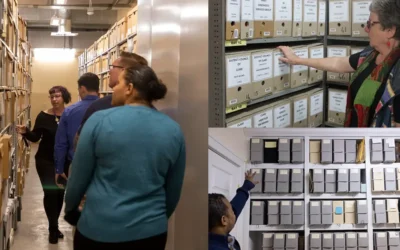Data Standards in Archival Collections Management Systems
Margot Note
Materials of enduring value contain metadata about their creation, organization, and use. Archivists also apply value-added information to arrange, describe, and enhance collections.
Archival data standards, used with best practices, ensure the quality, consistency, and interoperability of metadata. In addition, reliable query results from an archival collections management system (CMS) arise from controlled data. Data standards better protect collections by ensuring the preservation of information.
Why Use Data Standards?
Using data standards preserves the context of archival materials and helps protect the evidential value of records over time, eases their authentication, and helps users analyze the materials. Data standards help increase access to records, provide consistent information retrieval, and aid in increased data quality. They also help with the easier adaption of technology developments, the efficient export of data into other systems, better data exchange with the repository and other institutions, and more straightforward web publication.
Data standards provide the opportunity for linked data to enhance access to records. While the use of established encoding standards eases sharing of records and user searches across institutional boundaries, linked data applications can create pathways between archival records and external data sources, thus enhancing users’ understanding of records and their creators. This can also make archival data more available online, facilitating the exploration and use of archival materials to new or novice users.
A Data Standard Trio
Three elements of data standards enable consistency across one-of-a-kind collections. Data structure standards note the information archivists want to record by identifying required or optional fields. Data structure standards examples include the Dublin Core Metadata Element Set and Encoded Archival Description (EAD).
Data content standards describe content and supply guidelines for data value formats and syntax. Two common data content standards are Describing Archives: A Content Standard (DACS) and Resource Description and Access (RDA). Archivists can create local guidelines for entering data into fields, such as choices related to style, grammar, abbreviations, and organizational references.
Data value standards define terminologies used for fields and authorities (lists of acceptable values) that ensure data consistency. These are the actual data that populates data structures or metadata element sets, such as vocabularies, classifications, or thesauri. Examples of data value standards include Library of Congress Subject Headings and Getty’s Art & Architecture Thesaurus.
Data standards deployed in collections management systems result in crucial information management in both the short and the long term. Consistent practices allow archivists to use the information in new and unforeseen ways to meet researchers’ needs. The existence of metadata proves critical to the continued accessibility and utility of archival records. Information preserved through data standards allows archivists to decode information and transform it into knowledge in future collections management systems.
Creating a Data Standards Policy
A data standards policy supplies guidelines for the records structure and identifies mandatory fields, formats, and contents. A policy ensures against data loss and enables information sharing by controlling and making consistent data. Archival collections management policies, especially those focusing on how information is structured and entered into a collections management system (CMS) can achieve this effort.
A data standard policy can document the new system structure guidelines, such as mandatory fields and content and format for each field. Other policies may include a maintenance and authority policy, which shows staff allowed to add, change, or delete records, clarifies procedures for editing information, and notes procedures for maintaining database backups. An access authority policy denotes who has access to view and use collections information.
Providing access to archival collections is complex and challenging. However, a successfully implemented CMS makes discovery easier. As research expectations increase, repositories have altered traditional practices to meet user needs. With a CMS, archivists look for ways to maximize their collections’ value to their patrons with internationally recognized data standards.
Margot Note
Margot Note, archivist, consultant, and author is a guest blogger for Lucidea, provider of ArchivEra, archival collections management software for today’s challenges and tomorrow’s opportunities. Read more of Margot’s posts.
Never miss another post. Subscribe today!
Similar Posts
Enhancing Collaboration; Methods for Archivists
Archivists can enhance collaboration through user-centric approaches and efficient processing methods based on customer service principles.
Navigating Selection in Archival Practice
The archival selection process is far from straightforward, given the limitations of long-term preservation and ongoing accessibility challenges.
Responsible Stewardship in Archival Practice
Responsible stewardship is a philosophy that guides the actions and decisions of archivists in safeguarding collective memory.
A Modern View of a City’s History via ArchivEra
Brief success story on City of Regina Archives’ use of ArchivEra to manage collections of legal, historical, administrative or financial significance
Hosting service
Enjoy all of the benefits of your Lucidea solution with secure, reliable, stress free hosting
Programs & incentives
No matter your size or budget, we’ve got you covered, today and tomorrow




Leave a Comment
Comments are reviewed and must adhere to our comments policy.
0 Comments